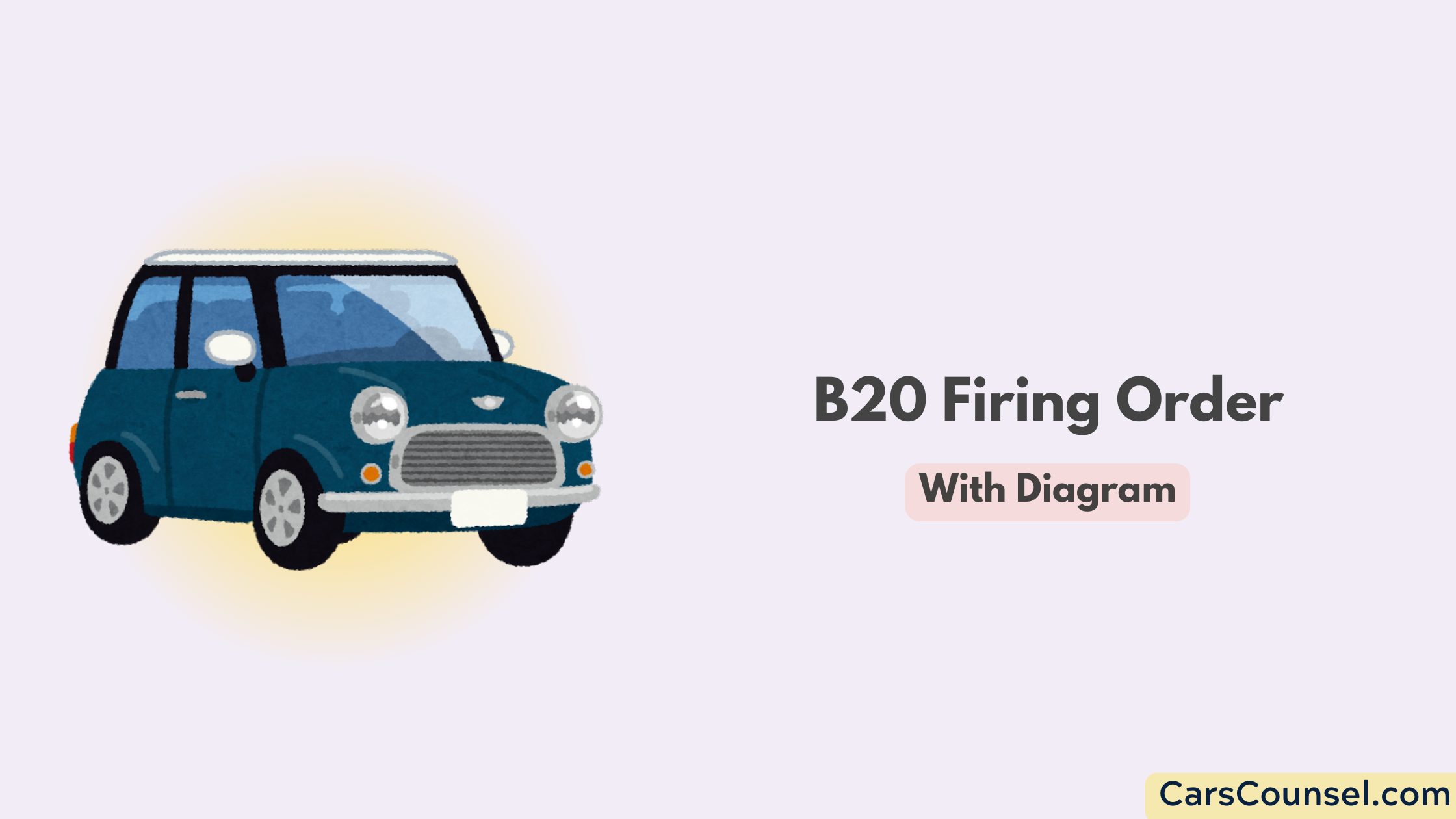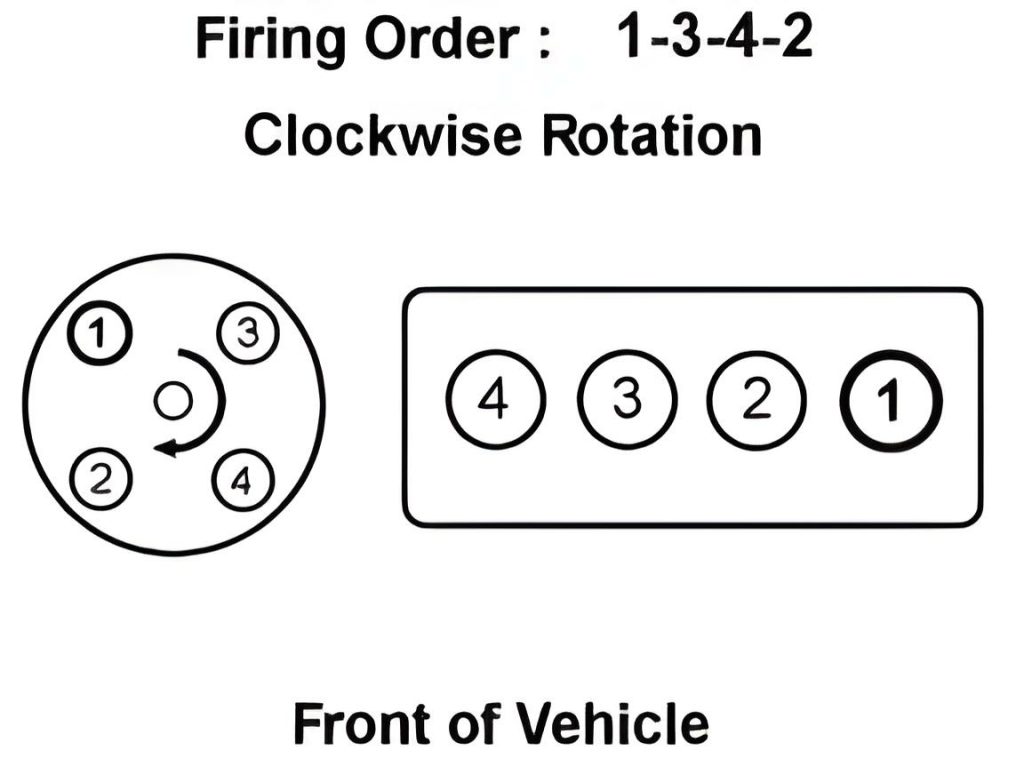For your B20 engine, whether it’s a B20B, B20B4, B20Z2, or B20A model, the firing order that aids in effective power transfer is 1-3-4-2. This order is a key element of the ignition timing and cylinder arrangement. The smooth start of an engine is disrupted if there’s any misalignment in this sequence.

Additionally, you can observe the firing pattern from the rotation of the distributor cap. Of course, if you were to delve deeper into B-series engines, you’ll discover more intriguing technical aspects, particularly related to torque specifications and the advantages of their distinct power characteristics.
Quick Navigation
Key Takeaways
- The B20 firing order follows a 1-3-4-2 sequence, critical for efficient power transfer and ignition timing.
- Misalignment in the firing order can cause issues with engine start-up and smooth operation.
- The distributor cap rotation in B20 engines visually demonstrates the firing pattern.
- This firing order is applicable to several B20 models including B20B, B20B4, B20Z2, and B20A, known for their robustness, reliability, and durability.
- A diagram can help visualize the firing order, ensure proper alignment, and aid in understanding the engine’s operation.
Understanding B20 Firing Order

To fully understand the B20 firing order, you must recognize that the sequence of 1-3-4-2 is essential for efficient power transfer and successful engine combustion. This order is paramount to the operation of your engine – it dictates when each cylinder’s spark plug ignites, directly impacting ignition timing and cylinder arrangement.
Start by identifying the first cylinder, which serves as your starting point. Misaligning this sequence disrupts the engine’s smooth start. The distributor cap’s rotation shows the pattern of this firing order, ensuring each cylinder fires at the correct time.
Understanding this sequence helps you to optimize your engine’s performance and longevity. Overlooking or misinterpreting this specific sequence can lead to inefficient combustion, and may potentially damage your engine.
Applicable Models for B20 Firing
The B20 firing order of 1-3-4-2 isn’t just relevant to one model, it’s applicable to several B-Series engines, including the B20B, B20B4, B20Z2, and B20A. These engines, with their unique firing order, are popular options for various B20 engine upgrades and modifications.
- B20B: Known for robustness, it’s a favorite pick for engine tuning and optimization.
- B20B4: This engine shares the same firing order and is often chosen for modifications due to its reliability.
- B20Z2 and B20A: Both these models are suitable for B20 engine tuning and upgrades, offering a balanced blend of performance and durability.
Torque Specifications Overview
Understanding the accurate torque specifications is essential when working with B-Series engines, as improper torque can lead to serious engine damage. Bolt tightening is a critical aspect of engine maintenance, ensuring power transfer and combustion efficiency.
For instance, the 7/16 in. Outer Main Cap Bolt has a torque specification of 70 ft.-lbs., while the Inner Main Cap Bolt, of the same size, demands 75 ft.-lbs. For the 3/8 in. Outer Main Cap Bolt, adhere to a 35 ft.-lbs. torque specification.
The Connecting Rod Bolts, sized 11/32 in. and 3/8 in., require 38-44 ft.-lbs. and 40-45 ft.-lbs., respectively. Importantly, these specifications may vary, hence always double-check these values from reliable sources before proceeding with any engine maintenance.
Firing Order in Similar Vehicles
Diving into other vehicles, it’s fascinating to note that the 2020 Honda Civic, Audi A4, Kia Stinger, Toyota Camry, and Mazda3 all share the same firing order as the B20 series: 1-3-4-2. This consistency isn’t coincidental but a deliberate strategy to boost engine efficiency.
- Cylinder sequence: The firing order 1-3-4-2 promotes balanced engine operation, reducing vibrations and improving overall vehicle performance.
- Engine efficiency: This shared firing sequence allows for best fuel usage, ensuring that each cylinder fires in a way that maximizes power output.
- Reduced engine wear: The 1-3-4-2 sequence reduces stress on the engine parts, increasing the engine’s lifespan.
Best B-Series Engine Explained
While the shared firing order among various vehicles promotes engine longevity and efficiency, let’s focus our attention on the B-Series engines, particularly identifying which one stands out as the best.
Among these, the B18 series is often touted as the top choice. Its reputation is largely due to the B18C powertrain, which cleverly combines superior features with impressive B Series power. It incorporates VTEC technology, delivering a seamless blend of low-end power and high-end performance. This engine’s capacity is 1.8 liters, making it a highly sought-after option for those who prioritize performance.
But remember, it’s not just about power. The use of VTEC technology also guarantees a streamlined idle and excellent fuel economy. This balance makes the B18 series the best in the B-Series engines.
Advantages of B-Series Engine
Often overlooked, the B-Series engine boasts several key advantages that make it a standout choice for both automotive enthusiasts and everyday drivers. First and foremost, it leverages the VTEC technology benefits. This allows for a remarkable balance between low-end power and high-end performance.
Secondly, the B-Series engine showcases unique engine power characteristics. It offers a range of power output without compromising on fuel efficiency.
Lastly, the B-Series engine is renowned for its dependability. Its robust design and high-quality construction guarantee that it withstands the test of time, providing you with a lasting engine solution.
In short, the B-Series is a remarkable blend of power, performance, and dependability, making it a worthy consideration for your engine needs.
Vehicles With B20 Engine
If you’re considering vehicles equipped with the B20 engine, you’ll find it under the hood of the first generation Honda CR-V, a model known for its performance and reliability. This engine is also found in certain models of the Honda Stepwgn and the Honda Orthia.
These vehicles are often the subject of B20 engine modifications, with car enthusiasts worldwide enjoying the opportunities for B20 engine tuning this setup offers.
| Vehicle Model | B20 Engine Variant |
|---|---|
| Honda CR-V | B20B, B20Z |
| Honda Stepwgn | B20B |
| Honda Orthia | B20B |
B20 engines offer a great balance of power and efficiency, making them a popular choice for those seeking to modify or tune their vehicles for improved performance.
B20 Engine Performance and Reliability
You’ll find that the B20 engine provides impressive performance and reliability, thanks to its robust design and efficient combustion process. But, to truly tap into its potential, you’ll need to focus on three key areas:
- B20 Engine Tuning:
Ideal tuning is necessary for achieving peak performance. This involves adjusting the air-fuel ratio, ignition timing, and VTEC engagement point. Proper tuning can significantly boost the engine’s power output.
- B20 Engine Maintenance:
Regular maintenance is essential for ensuring reliability. This includes routine oil changes, timing belt replacements, and spark plug inspections.
- Component Upgrades:
High-quality aftermarket parts can improve the engine’s longevity and performance. For example, a free-flowing exhaust system or performance intake manifold can provide noticeable improvements.
Conclusion
In the grand ballet of engine operation, knowing your B20’s firing order is key. From torque specs to performance benefits, understanding the B20 engine’s choreography leads to a smoother ride.
Your journey into the mechanical maze is just beginning, with the knowledge of the 1-3-4-2 firing order being your North Star. So grease up those mechanical elbows and let’s amp up your engine know-how.
After all, a well-tuned engine is music to every car enthusiast’s ears.

